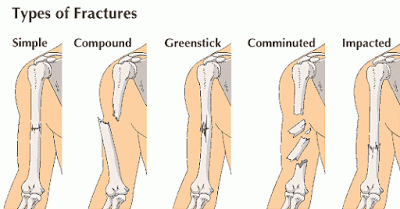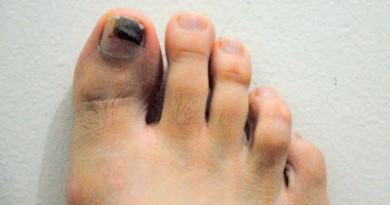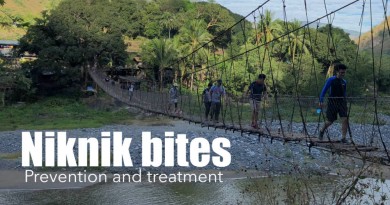Sprains and fractures: prevention and first aid
 This is an article belonging to the ‘climb health‘ category in PinoyMountaineer. Information provided in this article are based on research and are not meant as a substitute to actual medical advice and healthcare.
This is an article belonging to the ‘climb health‘ category in PinoyMountaineer. Information provided in this article are based on research and are not meant as a substitute to actual medical advice and healthcare.
BACKGROUND
Perhaps the most common health problem that affects climbing are sprains, and one of the more common mountain emergencies are fractures. Every climber must know the causes of these musculoskeletal problems, the ways to prevent it, and most importantly, how to deal with them while in the outdoors.
SPRAINS
A sprain is an injury to the ligaments (fibrous tissues that connects bones) due to sudden overstretching. In hiking, this commonly happens with a misstep, in which you stumble and trip on your foot (natapilok), stretching the ligaments of your ankles. This is called your ankle sprain. Another common injury is to the knee, especially when descending. Getting off-balanced with your foot getting flexed or extended in an abnormal position can lead to a knee sprain. The ankle and the knee are the most common sites of sprain, especially among mountain climbers.
Symptoms. You will feel sprain as sudden pain and loss of function. If its an ankle sprain, you would feel that there is a particular range of motion that you are unable to perform, or it is too painful to do so.
Danger signs. Sudden, intense pain and rapid onset of swelling and bruising would suggest a torn ligament. If the hiker cannot walk and if the mechanism of injury suggests a bad fall, a fracture may be suspected. If you have these, discontinue your climb and seek medical attention immediately. Ask assistance so you can descend properly, as much as possible avoiding movement by the affected ankle or knee.
Treatment. The treatment of sprain is summarized into the ‘RICE’ mnemonic, which stands for ‘Rest, Ice, Compression, and Elevation’. When you suffer a sprain, try to rest if possible. I doubt if you would find ice in the mountains (cold compression is recommended for sprains), but compression is available in the form of bandages and ankle/knee support which you can wear. Elevation – raising the knee above heart level – is also advised to prevent inflammation, but you can only do this while camped.
Medications. Sprain produces pain and inflammation, and these are the targets for drug therapy. Taking Paracetamol 500mg 4x/day or Ibuprofen 400mg 4x/day are accessible, cheap measures to manage mild sprain while on the mountains; stronger drugs include Celecoxib and Naproxen. Topical ointments such as Omega or Ben-Gay are also helpful to relieve pain.
Prevention. A joint system is overwhelmed, causing sprain. To prevent it from recurring, wearing ankle or knee support strengthens the joint system, lessening chances of it being overwhelmed.
Conclusion: Mild sprain is a common injury among hikers, and bringing basic medications like Paracetamol is good preparation. Also, bringing bandages is always a must for a group. Take note that if the symptoms are severe, the hiker must abort the climb immediately.
FRACTURES
(This section is still under construction and will be expanded soon)
Fractures are the most common outdoor recreational injuries in the United States, accounting for over 27% of all injuries. In the Philippines the figure may be similar. If the lower extremity is the more common site for sprains, it is the upper extremity that is usually affected.
Recognizing a fracture is an important first aid skill in the outdoors. Check for the following symptoms: severe pain (7-10 out of 10), difficulty in movement, and deformity or abnormal twist of the limb (a position that no normal movement can assume). Other symptoms include swelling, bruising, and bleeding.
There are two types of fracture: open or closed. An open fracture has a skin break, causing an open wound, whereas in a closed fracture the skin is not broken.
What to do. The mainstay of managing a fracture is immobilization. This is achieved by the use of splinting and bandages. The principle is immobilizing the affected area from the immediately proximal and distal joints (joints between which the fracture is). For example, if the fracture is in the forearm, then you immobilize the elbow and the wrist. If the fracture is open, you must control the bleeding first. Details of splinting and immobilization must be taught in person during actual training.
There is no first aid definitive treatment for fractures; the best you can do is to immobilize until the patient gets to a hospital and is treated by Orthopedics. In sum, while waiting for (or transporting the hiker to) medical help, the two things to do are (1) control bleeding and (2) immobilize the fractured body part.
What not to do. Do not massage the affected area, or attempt to straighten the broken bone. Also, avoid moving the fractured body part (common sense).






Leave a Reply
7 Comments on "Sprains and fractures: prevention and first aid"
Hi! To know more about knee sprain and its management, click here. You may also explore our website, The Knee Pain Guru to know more about knee pain management.
Good Day Gideon,
may I add this.
You should also have a cravat or a triangular bandage on your first aid kit (you know the cloth you wear on your neck during your boyscout years). You can use it as a mean to aply compression dressing on sprains. And as an arm sling should you need to immobilize am injury.
Levi S.
I am tapilok right now. Thanks for the info. Very very useful for the tapilok persons. GB MWAHXSZ.
I always do a 2 hour walk/run before a climb but a much tough training is advised if the climber will engage in more strenuous activity. to prepare the joints and muscles to stress for a prolonged period of time.
i need that advice coz' i have a sprain and i dunno how to deal with it.. 🙁